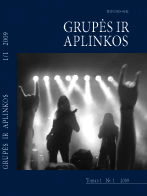Virtualios bendruomenės išraiškos
Virtual Identity Signs in Online Communication
Author(s): Aurelija DrevelSubject(s): Cultural Essay, Political Essay, Societal Essay
Published by: Vytauto Didžiojo Universitetas
Keywords: tapatybės konstravimas; virtualios bendruomenės; vartotojo ženklai; avataros, parašai; kompiuteriniai žaidimai; interneto forumai; IRC; naršyklių žaidimai; identity construction; online communities; user signs; avatar; signature; computer games; interne
Summary/Abstract: In computer-mediated virtual environments, users and communities appear as a set of on-screen virtual signs. In the online environment, users express their appearance, social position and cultural values through these signs. Their perception of other individuals in virtual space highly depends of the interpretation of these virtual clues. This process of interpretation can be seen as a different way to construct a personal or community identity that is unlike similar communication processes in real life. A virtual community, however, extends beyond the computer medium. In this sense, virtual environments can be seen merely as places for community meetings, while the sense and spirit of the community extends to real life. Values and habits of self-representation obtained online are followed also in real life, as well as interpersonal relations formed online continue in the real world. Belonging to the international online community can change even the core habits of users’ communications, for example, users may use English for most daily conversations instead of their native language. Regardless of the medium used for communication (IRC, online discussion boards, etc.), the community and individuals appear on-screen as a set of similar virtual signs. Some of these signs help users to identify affinity with other users, their cultural tastes, values and power in the online community. Differently from the often emphasized fragmentation of postmodern identity, more often than not, users tend to strive for personal integrity and self representation that is coherent, stable and not too far from their real life selves. Virtual signs also serve as criteria for a social choice. For example, users tend to avoid people with offensive nicknames and tasteless avatars or signatures – regardless if such virtual signs represent the real values of the person. On the other hand, virtual signs encourage communication by helping a user to identify groups or people who share the same interests and hobbies through provided cultural clues.
Journal: Grupės ir aplinkos
- Issue Year: 2009
- Issue No: 1
- Page Range: 177-197
- Page Count: 21
- Language: Lithuanian

